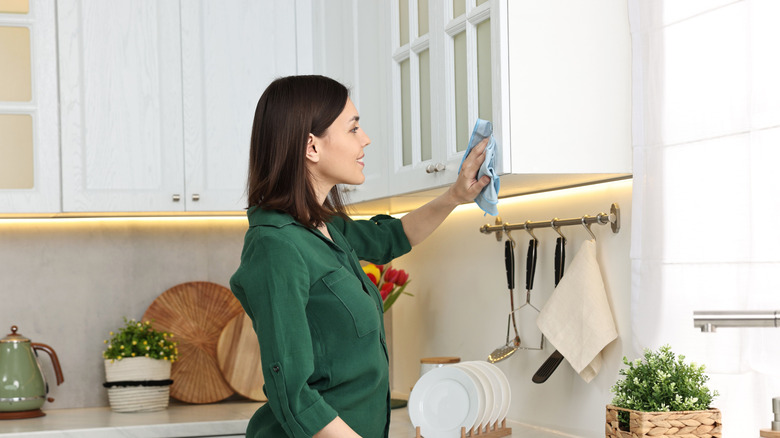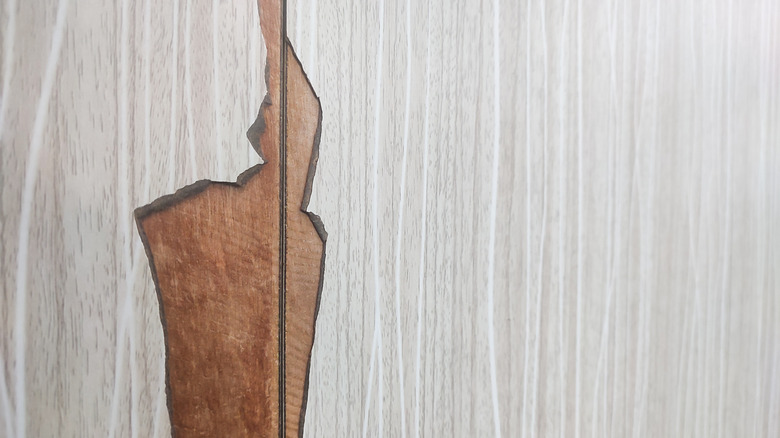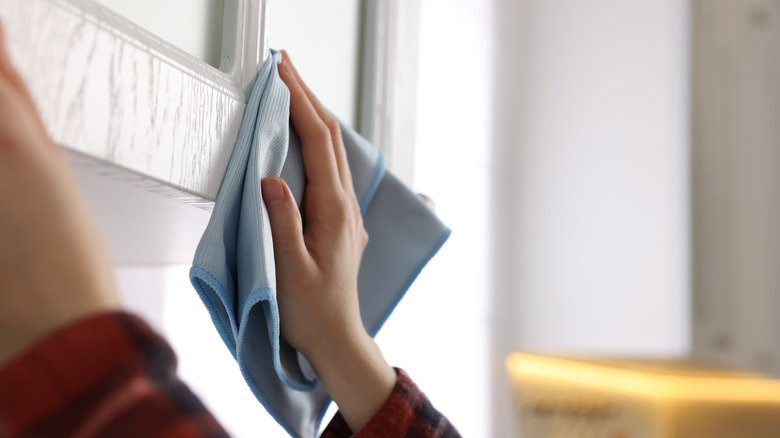The Popular Cleaning Solution That Does More Harm Than Good To Cabinets
We may receive a commission on purchases made from links.
One area of the home that always demands more attention when cleaning is the kitchen. Between doing dishes, clearing out the refrigerator, and trying to organize your cabinets like Marie Kondo, cleaning the kitchen can take all day. Remember to wipe down surfaces to keep everything sanitized and free of grease. However, don't just grab that bottle of Windex and start spraying it all over your cabinets. Your favorite blue surface cleaner may actually be damaging those clutter hiders.
To bring your old kitchen cabinets back to life, avoid cleaning them with ammonia, which is Windex's main ingredient. Because most wood cabinets have a lacquer finish or are painted, using a corrosive substance can strip those surfaces and cause permanent damage. The best cleaning solution to use on your cabinets is a mixture of warm water and a small amount of gentle dish soap. You will want to use a microfiber cleaning cloth for a gentler touch on those delicate surfaces.
How cleaning with Windex is damaging to your cabinets
The ingredient in Windex that can cause the most damage is ammonium hydroxide. This chemical compound is added to cleansers to break down grease and dirt. However, it can also chip away at the delicate surface of kitchen cabinets. That is why it is important to use Windex as intended — for a streak-free shine on your windows.
If you have veneered or painted cabinets, the ammonia in Windex can corrode the surface, causing the wood to peel and disintegrate. The window cleaner can also cause warping and discoloration of your cabinets. And if used long-term, it can erode the wood your cabinets are made from. By using the wrong cleanser on your cabinets, you could be throwing your money down the kitchen sink drain. It is best to follow the instructions from your cabinet maker and use a non-acidic gentle cleanser.
The best way to clean your cabinets
Before you begin cleaning your cabinets, you need to prep the area. Remove the items on your countertops to protect them from dust and cleaning solution. Thoroughly dust your cabinets. Then prepare two buckets: one with clean warm water and the other with a solution that includes a few drops of dish soap in warm water. You've probably guessed one bucket is for washing and the other is for rinsing. Dip your cloth into the soapy solution and wring out excess water. Wipe down your cabinets, targeting all the areas that are frequently touched. Once you have finished, wipe with the rinse cloth.
This solution is a simple and affordable way to degrease your kitchen cabinets. If you have an exceptionally sticky or greasy cabinet, you may need to clean it twice. After cleaning and rinsing, dry your cabinets off with a clean microfiber cloth to prevent warping. For areas that have scuff marks or residue that did not come off with the cleaning solution, you can gently use a product like this Magic Sponge to remove it. It's a good idea to clean your cabinets frequently so that they don't end up discolored by grime and grease.


